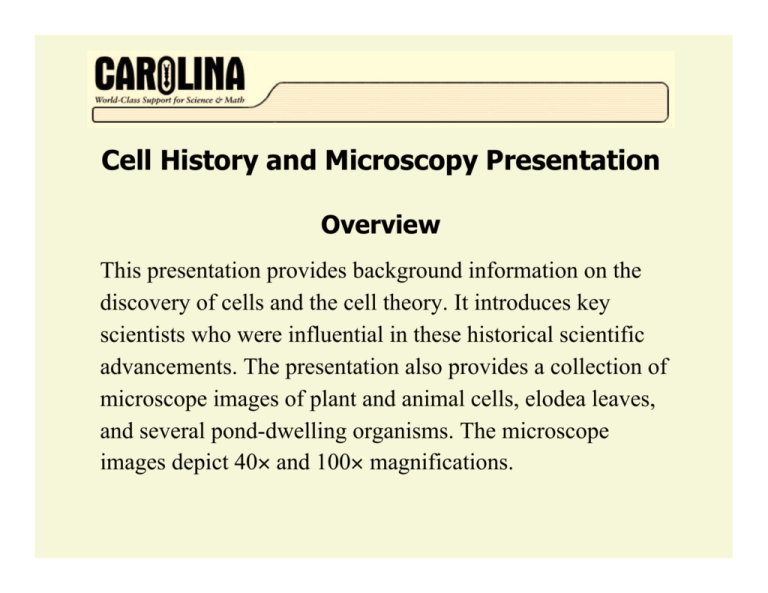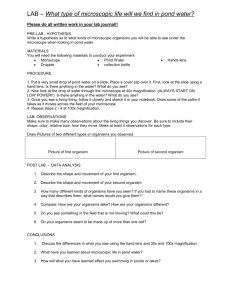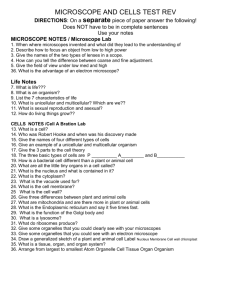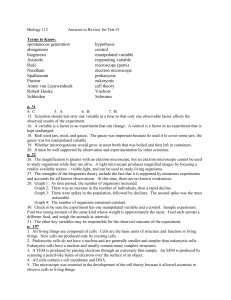Activity 2- Cell History and Microscopy
advertisement

Cell History and Microscopy Presentation Overview This presentation provides background information on the discovery of cells and the cell theory. It introduces key scientists who were influential in these historical scientific advancements. The presentation also provides a collection of microscope images of plant and animal cells, elodea leaves, and several pond-dwelling organisms. The microscope images depict 40 and 100 magnifications. The Discovery of Cells Cells are very small and they are not easily viewed using only your eyes. How did scientists discover cells? Microscopes An early microscope. In the late 1500s, scientists used lenses to create instruments that would magnify small objects and organisms. They called these tools microscopes. Microscopes gave scientists a window into the microscopic world. Robert Hooke (1635–1703) Robert Hooke was a scientist who used a microscope to look at thin sections of cork. Hooke observed that cork is made up of tiny, boxlike spaces. These spaces reminded Hooke of the small rooms, or cells, in a monastery, so he called the compartments “cells.” Robert Hooke’s drawing of cork cells. Anton van Leeuwenhoek (1632–1723) The cork cells that Robert Hooke studied were no longer alive. Anton van Leeuwenhoek was the first scientist to observe living cells under a microscope. Leeuwenhoek saw active unicellular organisms in a drop of pond water. He also observed live bacterial cells obtained from teeth scrapings. Image courtesy of the National Library of Medicine. The Importance of Cells Robert Hooke and Anton van Leeuwenhoek were among the first scientists to study cells. However, the importance of cells was not known until more than 150 years later. Why are cells so important? The Importance of Cells In the 1800s, the quality of microscopes improved greatly. This allowed scientists to observe cells in even more detail. Scientists began to develop the idea that the cell is the basic unit of life. Matthias Schleiden (1804–1881) Matthias Schleiden was a botanist who used a microscope to study plant tissues. Through his observations, he concluded that plants are made of cells. Theodor Schwann (1810–1882) A zoologist named Theodor Schwann applied Schleiden’s use of the microscope to animal tissue. He determined that animals are also made of cells. Rudolf Virchow (1821–1902) Rudolf Virchow determined that all cells come from existing cells through a process of cell division. The Cell Theory The cell theory incorporates the ideas of Schleiden, Schwann, and Virchow. The cell theory states: * All living things are made up of one or more cells. * The cell is the basic unit of structure and function in all organisms. * Cells come from existing cells. Microscopy The following slides show images of cells and microscopic organisms as viewed through modern microscopes. Microscope Image Cork Cells This is a microscope image of plant cells from cork. Microscope Image Onion Cells This is a microscope image of plant cells from an onion. Microscope Image Human Cheek Cell This is a microscope image of an animal cell. Microscope Images of Elodea Leaf 40 magnification 100 magnification cell Elodea is a multicellular, aquatic (water) plant. Can you see individual cells in the images above? Microscope Images of Pond Organisms 40 magnification spirogyra volvox Volvox is a multicellular, freshwater organism made up of thousands of individual cells. Spirogyra is a multicellular, strand-like organism that also lives in fresh water. The tiny specks in the images are unicellular (single-celled) organisms. Microscope Images of Pond Organisms 40 magnification planarian Planaria are multicellular flatworms that live in fresh water. Can you see the planarian’s eyes? Microscope Images of Pond Organisms 40 magnification hydra Hydra is a multicellular, freshwater organism. It has tentacles for catching smaller organisms to eat. Microscope Images of Pond Organisms 40 magnification daphnia Daphnia are multicellular organisms called water fleas. Can you see the daphnia’s eyes and internal organs? Microscope Images of Pond Organisms 100 magnification spirogyra volvox and spirogyra The higher magnification in these images and on the following slides reveals small organisms in more detail. Microscope Images of Pond Organisms 100 magnification spirogyra and unicellular organisms planarian head and eyes Microscope Images of Pond Organisms 100 magnification hydra tentacle daphnia









